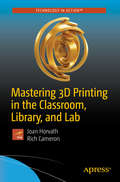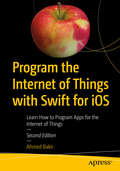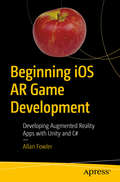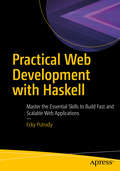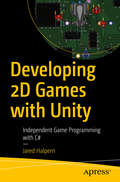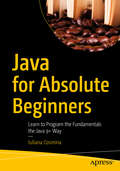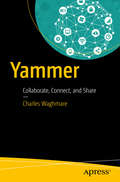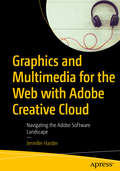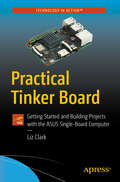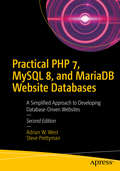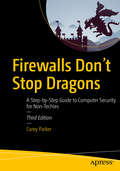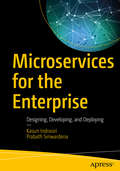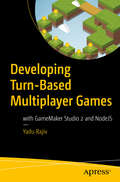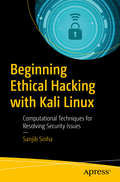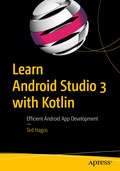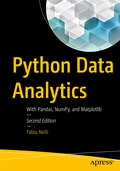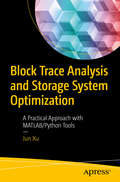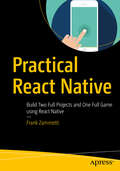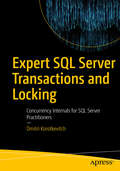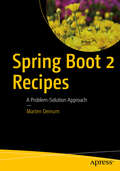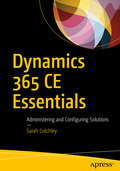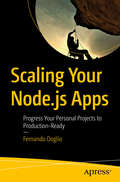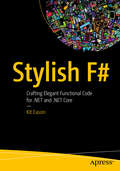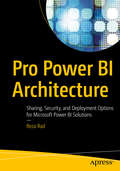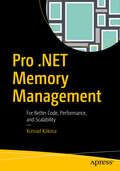- Table View
- List View
Mastering 3D Printing in the Classroom, Library, and Lab
by Joan Horvath Rich CameronLearn how to manage and integrate the technology of 3D printers in the classroom, library, and lab. With this book, the authors give practical, lessons-learned advice about the nuts and bolts of what happens when you mix 3D printers, teachers, students, and the general public in environments ranging from K-12 and university classrooms to libraries, museums, and after-school community programs.Take your existing programs to the next level with Mastering 3D Printing in the Classroom, Library, and Lab. Organized in a way that is readable and easy to understand, this book is your guide to the many technology options available now in both software and hardware, as well as a compendium of practical use cases and a discussion of how to create experiences that will align with curriculum standards. You'll examine the whole range of working with a 3D printer, from purchase decision to curriculum design. Finally this book points you forward to the digital-fabrication future current students will face, discussing how key skills can be taught as cost-effectively as possible.What You’ll LearnDiscover what is really involved with using a 3D printer in a classroom, library, lab, or public spaceReview use cases of 3D printers designed to enhance student learning and to make practical parts, from elementary school through university research labLook at career-planning directions in the emerging digital fabrication arenaWork with updated tools, hardware, and software for 3D printingWho This Book Is ForEducators of all levels, both formal (classroom) and informal (after-school programs, libraries, museums).
Program the Internet of Things with Swift for iOS: Learn How to Program Apps for the Internet of Things
by Ahmed BakirLearn how to build apps using Apple’s native APIs for the Internet of Things, including the Apple Watch, HomeKit, and Apple Pay. You'll also see how to interface with popular third-party hardware such as the Raspberry Pi, Arduino, and the FitBit family of devices.Program the Internet of Things with Swift and iOS is an update to the previous version and includes all new Swift 4 code. This book is a detailed tutorial that provides a detailed "how" and "why" for each topic, explaining Apple-specific design patterns as they come up and pulling lessons from other popular apps. To help you getting up and running quickly, each chapter is framed within a working project, allowing you to use the sample code directly in your apps.The Internet of Things is not limited to Apple devices alone, so this book also explains how to interface with popular third-party hardware devices, such as the Fitbit and Raspberry Pi, and generic interfaces, like Restful API’s and HTTPS. You'll also review new API's like Face ID and new design considerations, and look more closely at SSL and how to make IoT connected apps more resistant to hackers. The coverage of Apple Watch has been expanded as well. The Internet of Things is waiting — be a part of it!What You'll LearnUse Apple's native IoT Frameworks, such as HealthKit, HomeKit, and FaceIDInteract with popular third-party hardware, such as the Raspberry Pi, Arduino, and FitBitWork with real projects to develop skills based in experienceMake a smarter IoT with SiriKit and CoreMLWho This Book Is For The primary audience for this book are readers who have a grasp of the basics of iOS development and are looking to improve their Internet of Things-specific skills. Intermediate to Advanced level. The secondary audience would be business decision makers (managers, business analysts, executives) who are looking to gain a rough understanding of what is involved in Internet of Things development for iOS.
Beginning iOS AR Game Development: Developing Augmented Reality Apps with Unity and C#
by Allan FowlerCreate a fully featured application that’s both sophisticated and engaging. This book provides a detailed guide in developing augmented reality games that can take advantage of the advanced capabilities of new iOS devices and code while also offering compatibility with still supported legacy devices. No programming experience is necessary as this book begins on the ground floor with basic programming concepts in Unity and builds to incorporating input from the real world to create interactive realities. You’ll learn to program with the Unity 2017 development platform using C#. Recent announcements of increased AR capabilities on the latest iPhones and iPads show a clear dedication on Apple’s part to this emerging market of immersive games and apps. Unity 2017 is the latest version of this industry leading development platform and C# is a ubiquitous programming language perfect for any programmer to begin with. Using the latest development technologies, Beginning iOS AR Game Development will show you how to program games that interact directly with the real world environment around the user for creative fantastic augmented reality experiences.What You'll LearnDownload assets from the Unity storeCreate a scene in Unity 2017Use physics and controls on mobile devicesWho This Book Is ForBeginner programmers and/or people new to developing games using Unity. It also serves as a great introduction to developing AR games and educators teaching the subject at high school or higher levels.
Practical Web Development with Haskell: Master the Essential Skills to Build Fast and Scalable Web Applications
by Ecky PutradyLearn how to advance your skill level of Haskell, and use this language for practical web development. This book uses a direct, no nonsense approach, so you no longer need to spend extra time reading the documentation, blog posts, and forums to understand how to use Haskell – all that knowledge is provided in one coherent resource. You'll start by reviewing how multiple facets of web development are done in Haskell, such as routing, building HTMLs, interacting with databases, caches, and queues, etc. You'll then move on to using notable libraries, such as "scotty" for routings, "digestive-functor" for input validation, and "postgresql-simple" for interacting with databases. In the later chapters, you'll learn how all of these libraries can be used together by working on a fully functioning project deployed on Heroku. What You'll Learn Set up a productive Haskell development environmentReview basic tasks that are encountered when building web applications.Explore how to interact with external systems, such as databases, queues, and RESTful APIs. Build a RESTful API, website, building views and form validation.Who This Book Is ForSoftware developers familiar Haskell and would like to apply the knowledge on real world applications and software developers new to Haskell.
Developing 2D Games with Unity: Independent Game Programming with C#
by Jared HalpernFollow a walkthrough of the Unity Engine and learn important 2D-centric lessons in scripting, working with image assets, animations, cameras, collision detection, and state management. In addition to the fundamentals, you'll learn best practices, helpful game-architectural patterns, and how to customize Unity to suit your needs, all in the context of building a working 2D game. While many books focus on 3D game creation with Unity, the easiest market for an independent developer to thrive in is 2D games. 2D games are generally cheaper to produce, more feasible for small teams, and more likely to be completed. If you live and breathe games and want to create them then 2D games are a great place to start. By focusing exclusively on 2D games and Unity’s ever-expanding 2D workflow, this book gives aspiring independent game developers the tools they need to thrive. Various real-world examples of independent games are used to teach fundamental concepts of developing 2D games in Unity, using the very latest tools in Unity’s updated 2D workflow. New all-digital channels for distribution, such as Nintendo eShop, XBox Live Marketplace, the Playstation Store, the App Store, Google Play, itch.io, Steam, and GOG.com have made it easier than ever to discover, buy, and sell games. The golden age of independent gaming is upon us, and there has never been a better time to get creative, roll up your sleeves, and build that game you’ve always dreamed about. Developing 2D Games with Unity can show you the way.What You'll LearnDelve deeply into useful 2D topics, such as sprites, tile slicing, and the brand new Tilemap feature.Build a working 2D RPG-style game as you learn.Construct a flexible and extensible game architecture using Unity-specific tools like Scriptable Objects, Cinemachine, and Prefabs.Take advantage of the streamlined 2D workflow provided by the Unity environment. Deploy games to desktopWho This Book Is For Hobbyists with some knowledge of programming, as well as seasoned programmers interested in learning to make games independent of a major studio.
Java for Absolute Beginners: Learn to Program the Fundamentals the Java 9+ Way
by Iuliana CosminaWrite your first code in Java using simple, step-by-step examples that model real-word objects and events, making learning easy. With this book you’ll be able to pick up the concepts without fuss. Java for Absolute Beginners teaches Java development in language anyone can understand, giving you the best possible start. You’ll see clear code descriptions and layout so that you can get your code running as soon as possible. After reading this book, you'll come away with the basics to get started writing programs in Java.Author Iuliana Cosmina focuses on practical knowledge and getting up to speed quickly—all the bits and pieces a novice needs to get started programming in Java. First, you’ll discover how Java is executed, what type of language it is, and what it is good for. With the theory out of the way, you’ll install Java, choose an editor such as IntelliJ IDEA, and write your first simple Java program. Along the way you’ll compile and execute this program so it can run on any platform that supports Java. As part of this tutorial you’ll see how to write high-quality code by following conventions and respecting well-known programming principles, making your projects more professional and efficient.Finally, alongside the core features of Java, you’ll learn skills in some of the newest and most exciting features of the language: Generics, Lambda expressions, modular organization, local-variable type inference, and local variable syntax for Lambda expressions.Java for Absolute Beginners gives you all you need to start your Java 9+ programming journey. No experience necessary. What You'll LearnUse data types, operators, and the new stream APIInstall and use a build tool such as GradleBuild interactive Java applications with JavaFX Exchange data using the new JSON APIs Play with images using multi-resolution APIsUse the publish-subscribe frameworkWho This Book Is ForThose who are new to programming and who want to start with Java.
Yammer: Collaborate, Connect, and Share
by Charles WaghmareBuild a successful Yammer implementation, make your workplace social and collaborative, create a culture of sharing, form expert communities and generate innovative solutions. Besides, this book will help to enhance your collaboration your suppliers, partners, and clients. The author starts by giving an introduction to social collaborations and successful implementations of Yammer. Along the way, he explains the art of community management in Yammer using his hands-on experience of building communities. He then explains methods to keep a Yammer network engaged followed by a description of running a campaign on Yammer. The second part of Yammer begins with ways you can engage entire organizations, including executives, on Yammer along with methods to measure the success of a Yammer network. You’ll see how to get to grips with integrating Yammer with an existing platform and how to collaborate with customers, suppliers, and partners using Yammer. Finally, you’ll learn various innovative techniques of communication using Yammer and explore the author’s vision of the next-generation Yammer platform After reading this book you will understand how to make successful Yammer implementations, engage communities on Yammer, and accomplish business goals using Yammer.What You Will LearnMaster the art of community managementMake your organization digital by implementing and integrating Yammer Break silos and create a collaborative workforceKeep Yammer groups live and full of participationImprove collaboration between suppliers, partners, and clientsMeasure the success of your Yammer networkIncrease employee engagement on Yammer Who This Book Is ForYammer adoption managers, community managers, customer success managers, and Yammer group admins.
Graphics and Multimedia for the Web with Adobe Creative Cloud: Navigating the Adobe Software Landscape
by Jennifer HarderUpgrade your skills in Adobe Creative Cloud and enhance your corporate or personal website with multimedia and graphics. In this book you'll look at the latest versions of five core Adobe programs: Photoshop, Illustrator, Animate (formerly Flash), Media Encoder and Dreamweaver. As you work with each of these programs to create images, animations, audio and video you will see how each one can help you complete and finally integrate your multimedia files into a final mobile friendly website.Adding new multimedia features to your website does not have to be difficult or confusing. If you plan your route and goals correctly, along the way you will see how each software has its own use, but ultimately, how they can all work together for a common goal. This book also shows you how additional Creative Cloud software can be used with the core five programs should you want to add further interactivity.What You'll Learn:Use Adobe Creative Cloud software to create graphics and multimedia for a websiteRender images in various formatsWork with video, HTML5 Canvas and audio files for the websiteDiscover new features of HTML5 and CSS3 and how to work with them in Dreamweaver CCWho This Book Is ForGraphic designers who are creating websites; students in the classroom; instructors wanting to upgrade their Adobe Creative Cloud skills.
Practical Tinker Board: Getting Started and Building Projects with the ASUS Single-Board Computer
by Liz ClarkGet started with the ASUS Tinker Board and begin building and expanding your own projects. This book covers the basic operating systems offered by ASUS for the Tinker Board and Tinker Board S, TinkerOS and Android, and then dives deeper into its capabilities for projects; such as a music streamer or a weather display with internet connectivity. Beginners will find the resources necessary to follow along and more seasoned makers can review additional information to engage with this new single-board computer platform. The projects are broad enough to show off the capability of the Tinker Board’s hardware and they can be used as is or you can add to them based on your skill level. The ASUS Tinker Board offers an increase in hardware specs and, as a result, is more powerful compared to other single-board computers on the market, making it a great option for projects that would have previously been a challenge to run on other boards, such as the Raspberry Pi. Single-board computers in general are also gaining in popularity as solutions for many DIY tech projects, ranging from gaming to file storage to being a small form factor desktop Linux computer. Practical Tinker Board is a great resource to the maker community, enabling people to begin truly exploring the Tinker Board. What You’ll Learn:Review ASUS Tinker Board's capabilities and functionsGain a deeper understanding of different Linux distributionsBuild useful projects with a range of hardware and softwareTake an in-depth look at how to install, configure and use ASUS Tinker Board in projectsWho This Book Is For:Those who have previously worked on some beginner maker projects, such as basic Arduino and Raspberry Pi projects, and are looking to expand their skills and knowledge of Linux, single board computers, programming and project builds.
Practical PHP 7, MySQL 8, and MariaDB Website Databases: A Simplified Approach to Developing Database-Driven Websites
by Steve Prettyman Adrian W. WestBuild interactive, database-driven websites with PHP 7, MySQL 8, and MariaDB. The focus of this book is on getting you up and running as quickly as possible with real-world applications. In the first two chapters, you will set up your development and testing environment, and then build your first PHP and MariaDB or MySQL database-driven website. You will then increase its sophistication, security, and functionality throughout the course of the book. The PHP required is taught in context within each project so you can quickly learn how PHP integrates with MariaDB and MySQL to create powerful database-driven websites. Each project is fully illustrated, so you will see clearly what you are building as you create your own database-driven website. You will build a form for registering users, and then build an interface so that an administrator can view and administer the user database. You will create a message board for users and a method for emailing them. You will also learn the best practices for ensuring that your website databases are secure. Later chapters describe how to create a product catalog, and a simple e-commerce site. You will also discover how to migrate a database to a remote host. The final chapter will demonstrate the advantages of migrating to Oracle's MySQL 8. You will be shown step by step migration directions along with a demonstration of the tools available in SQL Workbench. Because you are building the interactive pages yourself, you will know exactly how MySQL, MariaDB, and PHP all work together, and you will be able to add database interactivity to your own websites with ease.What You Will LearnBuild a secure database-driven website using PHP 7, MySQL 8, and MariaDBCreate a product catalogWrite a message boardMove towards e-commerceEmploy security and validation measuresMigrate to Oracle's MySQL 8 Server platformWho This Book Is For Web developers with HTML, CSS and a limited Bootstrap experience. Readers need little to no prior experience with PHP and MySQL.
Firewalls Don't Stop Dragons: A Step-by-Step Guide to Computer Security for Non-Techies
by Carey ParkerRely on this practical, end-to-end guide on cyber safety and online security written expressly for a non-technical audience. You will have just what you need to protect yourself—step by step, without judgment, and with as little jargon as possible. Just how secure is your computer right now? You probably don't really know. Computers and the Internet have revolutionized the modern world, but if you're like most people, you have no clue how these things work and don't know the real threats.Protecting your computer is like defending a medieval castle. While moats, walls, drawbridges, and castle guards can be effective, you'd go broke trying to build something dragon-proof. This book is not about protecting yourself from a targeted attack by the NSA; it's about armoring yourself against common hackers and mass surveillance. There are dozens of no-brainer things we all should be doing to protect our computers and safeguard our data—just like wearing a seat belt, installing smoke alarms, and putting on sunscreen. Author Carey Parker has structured this book to give you maximum benefit with minimum effort. If you just want to know what to do, every chapter has a complete checklist with step-by-step instructions and pictures. The book contains more than 150 tips to make you and your family safer. It includes: Added steps for Windows 10 (Spring 2018) and Mac OS X High SierraExpanded coverage on mobile device safetyExpanded coverage on safety for kids onlineMore than 150 tips with complete step-by-step instructions and pictures What You’ll LearnSolve your password problems once and for allBrowse the web safely and with confidenceBlock online tracking and dangerous adsChoose the right antivirus software for youSend files and messages securelySet up secure home networkingConduct secure shopping and banking onlineLock down social media accountsCreate automated backups of all your devicesManage your home computersUse your smartphone and tablet safelySafeguard your kids onlineAnd more! Who This Book Is For Those who use computers and mobile devices, but don’t really know (or frankly care) how they work. This book is for people who just want to know what they need to do to protect themselves—step by step, without judgment, and with as little jargon as possible.
Microservices for the Enterprise: Designing, Developing, and Deploying
by Prabath Siriwardena Kasun IndrasiriUnderstand the key challenges and solutions around building microservices in the enterprise application environment. This book provides a comprehensive understanding of microservices architectural principles and how to use microservices in real-world scenarios.Architectural challenges using microservices with service integration and API management are presented and you learn how to eliminate the use of centralized integration products such as the enterprise service bus (ESB) through the use of composite/integration microservices. Concepts in the book are supported with use cases, and emphasis is put on the reality that most of you are implementing in a “brownfield” environment in which you must implement microservices alongside legacy applications with minimal disruption to your business. Microservices for the Enterprise covers state-of-the-art techniques around microservices messaging, service development and description, service discovery, governance, and data management technologies and guides you through the microservices design process. Also included is the importance of organizing services as core versus atomic, composite versus integration, and API versus edge, and how such organization helps to eliminate the use of a central ESB and expose services through an API gateway.What You'll LearnDesign and develop microservices architectures with confidencePut into practice the most modern techniques around messaging technologies Apply the Service Mesh pattern to overcome inter-service communication challengesApply battle-tested microservices security patterns to address real-world scenariosHandle API management, decentralized data management, and observabilityWho This Book Is ForDevelopers and DevOps engineers responsible for implementing applications around a microservices architecture, and architects and analysts who are designing such systems
Developing Turn-Based Multiplayer Games: with GameMaker Studio 2 and NodeJS
by Yadu RajivCreate your first turn-based multiplayer game using GameMaker Studio 2’s built-in networking functions as well as using a simple NodeJS server. This book introduces you to the complexities of network programming and communication, where the focus will be on building the game from the ground up. You will start with a brief introduction to GameMaker Studio 2 and GML coding before diving into the essential principles of game design. Following this, you will go through an introductory section on NodeJS where you will learn how to create a server and send and receive data from it as well as integrating it with GameMaker Studio. You will then apply multiplayer gaming logic to your server and unlock multiplayer game features such as locating a player, syncing their data, and recording their session. What You Will LearnDiscover the architecture of GameMaker Studio 2 Add new features to your game with NodeJS modulesIntegrate GameMaker Studio 2 with NodeJS Master GameMaker Studio 2's built-in networking functionsWho This Book Is ForGameMaker Studio users who want to understand how the networking components of GMS 2 work. Basic JavaScript knowledge is required.
Beginning Ethical Hacking with Kali Linux: Computational Techniques for Resolving Security Issues
by Sanjib SinhaGet started in white-hat ethical hacking using Kali Linux. This book starts off by giving you an overview of security trends, where you will learn the OSI security architecture. This will form the foundation for the rest of Beginning Ethical Hacking with Kali Linux. With the theory out of the way, you’ll move on to an introduction to VirtualBox, networking, and common Linux commands, followed by the step-by-step procedure to build your own web server and acquire the skill to be anonymous . When you have finished the examples in the first part of your book, you will have all you need to carry out safe and ethical hacking experiments. After an introduction to Kali Linux, you will carry out your first penetration tests with Python and code raw binary packets for use in those tests. You will learn how to find secret directories on a target system, use a TCP client in Python, and scan ports using NMAP. Along the way you will discover effective ways to collect important information, track email, and use important tools such as DMITRY and Maltego, as well as take a look at the five phases of penetration testing. The coverage of vulnerability analysis includes sniffing and spoofing, why ARP poisoning is a threat, how SniffJoke prevents poisoning, how to analyze protocols with Wireshark, and using sniffing packets with Scapy. The next part of the book shows you detecting SQL injection vulnerabilities, using sqlmap, and applying brute force or password attacks. Besides learning these tools, you will see how to use OpenVas, Nikto, Vega, and Burp Suite. The book will explain the information assurance model and the hacking framework Metasploit, taking you through important commands, exploit and payload basics. Moving on to hashes and passwords you will learn password testing and hacking techniques with John the Ripper and Rainbow. You will then dive into classic and modern encryption techniques where you will learn the conventional cryptosystem. In the final chapter you will acquire the skill of exploiting remote Windows and Linux systems and you will learn how to own a target completely.What You Will LearnMaster common Linux commands and networking techniquesBuild your own Kali web server and learn to be anonymousCarry out penetration testing using PythonDetect sniffing attacks and SQL injection vulnerabilitiesLearn tools such as SniffJoke, Wireshark, Scapy, sqlmap, OpenVas, Nikto, and Burp SuiteUse Metasploit with Kali LinuxExploit remote Windows and Linux systemsWho This Book Is ForDevelopers new to ethical hacking with a basic understanding of Linux programming.
Learn Android Studio 3 with Kotlin: Efficient Android App Development
by Ted HagosBuild Android apps using the popular and efficient Android Studio 3 suite of tools, an integrated development environment (IDE) with which Android developers can now use the Kotlin programming language. With this book, you’ll learn the latest and most productive tools in the Android tools ecosystem, ensuring quick Android app development and minimal effort on your part. Along the way, you’ll use Android Studio to develop apps tier by tier through practical examples. These examples cover core Android topics such as Activities, Intents, BroadcastReceivers, Services and AsyncTask. Then, you’ll learn how to publish your apps and sell them online and in the Google Play store.What You’ll LearnUse Android Studio 3 to quickly and confidently build your first Android appsBuild an Android user interface using activities and layouts, event handling, images, menus and the action barIncorporate new elements including fragmentsLearn how data is persisted Use Kotlin to build appsWho This Book Is ForThose who may be new to Android Studio 3 or Android Studio in general. You may or may not be new to Android development in general. Some prior experience with Java is also recommended.
Python Data Analytics: With Pandas, NumPy, and Matplotlib
by Fabio NelliExplore the latest Python tools and techniques to help you tackle the world of data acquisition and analysis. You'll review scientific computing with NumPy, visualization with matplotlib, and machine learning with scikit-learn. This revision is fully updated with new content on social media data analysis, image analysis with OpenCV, and deep learning libraries. Each chapter includes multiple examples demonstrating how to work with each library. At its heart lies the coverage of pandas, for high-performance, easy-to-use data structures and tools for data manipulationAuthor Fabio Nelli expertly demonstrates using Python for data processing, management, and information retrieval. Later chapters apply what you've learned to handwriting recognition and extending graphical capabilities with the JavaScript D3 library. Whether you are dealing with sales data, investment data, medical data, web page usage, or other data sets, Python Data Analytics, Second Edition is an invaluable reference with its examples of storing, accessing, and analyzing data.What You'll LearnUnderstand the core concepts of data analysis and the Python ecosystemGo in depth with pandas for reading, writing, and processing dataUse tools and techniques for data visualization and image analysisExamine popular deep learning libraries Keras, Theano,TensorFlow, and PyTorchWho This Book Is ForExperienced Python developers who need to learn about Pythonic tools for data analysis
Block Trace Analysis and Storage System Optimization: A Practical Approach with MATLAB/Python Tools
by Jun XuUnderstand the fundamental factors of data storage system performance and master an essential analytical skill using block trace via applications such as MATLAB and Python tools. You will increase your productivity and learn the best techniques for doing specific tasks (such as analyzing the IO pattern in a quantitative way, identifying the storage system bottleneck, and designing the cache policy).In the new era of IoT, big data, and cloud systems, better performance and higher density of storage systems has become crucial. To increase data storage density, new techniques have evolved and hybrid and parallel access techniques—together with specially designed IO scheduling and data migration algorithms—are being deployed to develop high-performance data storage solutions. Among the various storage system performance analysis techniques, IO event trace analysis (block-level trace analysis particularly) is one of the most common approaches for system optimization and design. However, the task of completing a systematic survey is challenging and very few works on this topic exist. Block Trace Analysis and Storage System Optimization brings together theoretical analysis (such as IO qualitative properties and quantitative metrics) and practical tools (such as trace parsing, analysis, and results reporting perspectives). The book provides content on block-level trace analysis techniques, and includes case studies to illustrate how these techniques and tools can be applied in real applications (such as SSHD, RAID, Hadoop, and Ceph systems). What You’ll Learn Understand the fundamental factors of data storage system performanceMaster an essential analytical skill using block trace via various applicationsDistinguish how the IO pattern differs in the block level from the file levelKnow how the sequential HDFS request becomes “fragmented” in final storage devicesPerform trace analysis tasks with a tool based on the MATLAB and Python platformsWho This Book Is For IT professionals interested in storage system performance optimization: network administrators, data storage managers, data storage engineers, storage network engineers, systems engineers
Practical React Native: Build Two Full Projects and One Full Game using React Native
by Frank ZammettiDiscover how to use React Native in the real world, from scratch. This book shows you what React Native has to offer, where it came from, and where it’s going. You'll begin with a solid foundation of practical knowledge, and then build on it immediately by constructing three different apps. You'll learn how to use each feature of React Native by working on two full projects and one full game. These aren’t just simple React Native Hello World examples (although you’ll naturally start there!) but are apps that you can, if you so choose, install on your mobile devices and use for real. Throughout this book, you'll gain real-world familiarity with React Native as well as supporting components from Expo, NativeBase, React Navigation and the Redux and Lodash libraries. You'll also build server-side code for a mobile React Native app to talk to using the popular Node.js and Socket.io library, providing you a holistic view of things even beyond React Native. And, you'll see many helpful tips, tricks and gotchas to watch out for along the way!Practical React Native offers practical exercises that will give you a solid grasp of building apps with React Native, allowing you to springboard into creating more advanced apps on your own.Creating a game with React Native will allow you to see a whole other perspective on what React Native can do.What You'll Learn Master the basics of React NativeCreate a logically structured projectReview interface elements, such as widgets, controls, and extensionsBuild layoutsWork with Expo, an open source toolchain Who This book Is ForThe primary audience is mobile developers and anyone looking to build for multiple mobile platforms and trying to do so with a codebase that is largely the same across all. Readers will need a decent foundation, but not necessarily be experts in, HTML, CSS, and JavaScript, but I'll assume little beyond that.
Expert SQL Server Transactions and Locking: Concurrency Internals for SQL Server Practitioners
by Dmitri KorotkevitchMaster SQL Server’s Concurrency Model so you can implement high-throughput systems that deliver transactional consistency to your application customers. This book explains how to troubleshoot and address blocking problems and deadlocks, and write code and design database schemas to minimize concurrency issues in the systems you develop.SQL Server’s Concurrency Model is one of the least understood parts of the SQL Server Database Engine. Almost every SQL Server system experiences hard-to-explain concurrency and blocking issues, and it can be extremely confusing to solve those issues without a base of knowledge in the internals of the Engine. While confusing from the outside, the SQL Server Concurrency Model is based on several well-defined principles that are covered in this book.Understanding the internals surrounding SQL Server’s Concurrency Model helps you build high-throughput systems in multi-user environments. This book guides you through the Concurrency Model and elaborates how SQL Server supports transactional consistency in the databases. The book covers all versions of SQL Server, including Microsoft Azure SQL Database, and it includes coverage of new technologies such as In-Memory OLTP and Columnstore Indexes.What You'll LearnKnow how transaction isolation levels affect locking behavior and concurrencyTroubleshoot and address blocking issues and deadlocksProvide required data consistency while minimizing concurrency issuesDesign efficient transaction strategies that lead to scalable codeReduce concurrency problems through good schema designUnderstand concurrency models for In-Memory OLTP and Columnstore IndexesReduce blocking during index maintenance, batch data load, and similar tasksWho This Book Is ForSQL Server developers, database administrators, and application architects who are developing highly-concurrent applications. The book is for anyone interested in the technical aspects of creating and troubleshooting high-throughput systems that respond swiftly to user requests.
Spring Boot 2 Recipes: A Problem-Solution Approach
by Marten DeinumSolve all your Spring Boot 2 problems using complete and real-world code examples. When you start a new project, you’ll be able to copy the code and configuration files from this book, and then modify them for your needs. This can save you a great deal of work over creating a project from scratch.Using a problem-solution approach, Spring Boot 2 Recipes quickly introduces you to Pivotal's Spring Boot 2 micro-framework, then dives into code snippets on how to apply and integrate Spring Boot 2 with the Spring MVC web framework, Spring Web Sockets, and microservices. You'll also get solutions to common problems with persistence, integrating Spring Boot with batch processing, algorithmic programming via Spring Batch, and much more. Other recipes cover topics such as using and integrating Boot with Spring's enterprise services, Spring Integration, testing, monitoring and more.What You'll LearnGet reusable code recipes and snippets for the Spring Boot 2 micro-framework Discover how Spring Boot 2 integrates with other Spring APIs, tools, and frameworksAccess Spring MVC and the new Spring Web Sockets for simpler web developmentWork with microservices for web services development and integration with your Spring Boot applicationsAdd persistence and a data tier seamlessly to make your Spring Boot web application do moreIntegrate enterprise services to create a more complex Java application using Spring BootWho This Book Is ForExperienced Java and Spring programmers.
Dynamics 365 CE Essentials: Administering and Configuring Solutions
by Sarah CritchleyDiscover how to set up core Dynamics 365 Customer Engagement functionality and learn how to build more customized processes on top of the standard capabilities. This book starts by showing you how to set up the Dynamics 365 Online system for sales, customer service, marketing, field service, and Outlook integration. In the second section, you’ll work through UI customizations, process automation and reporting in Dynamics 365 CE. Learn about the App Framework, how to create model-driven apps and how to get started with the Common Data Service for Apps. Leverage Microsoft Flow within Dynamics 365 CE to create loosely coupled business applications using automation from Microsoft and third-party services.After reading Dynamics 365 CE Essentials, you will have mastered the core functionality available in Dynamics 365 CE and be able to set it up for a number of different scenarios. What You Will LearnSet up the core standard features of Dynamics 365 CECreate model-driven apps within Dynamics 365 customized to specific business needsCustomize Dynamics 365 CE and leverage process automation functionality through the UILearn about the Common Data Service for Apps Who This Book Is For Consultants, business analysts, administrators, and project managers who are looking for more information about Dynamics 365.
Scaling Your Node.js Apps: Progress Your Personal Projects to Production-Ready
by Fernando DoglioTake your Node.js application into production-ready status, capable of scaling up to whatever your needs might be. You'll discover that architecting for successful, popular sites is an essential tool of any professional Node.js developer, and learning to scale your own applications is a great place to start. Using this book you will learn when to scale, what factors should trigger scaling, and what architectural techniques are best suited for scaling. You will also explore common pitfalls that arise when scaling a Node.js application and solutions to correct them.Including analyses of success cases at the largest-scale companies, such as Netflix and Paypal, this book will get you started with scaling in no time at all. What You'll LearnDetermine what factors should trigger the need to scaleDiscover different architectural patterns that lend themselves to scalingResolve problems that arise when scaling up a Node.js applicationMonitor a platform in order to understand when to start scalingWho This Book Is ForThe main audience for this book are Node.js developers with a mid-level understanding of the technology. Novice Node users will also benefit from the coverage of generic scaling-related topics.
Stylish F#: Crafting Elegant Functional Code for .NET and .NET Core
by Kit EasonWhy just get by in F# when you can program in style! This book goes beyond syntax and into design. It provides F# developers with best practices, guidance, and advice to write beautiful, maintainable, and correct code. Stylish F# covers every design decision that a developer makes in constructing F# programs, helping you make the most educated and valuable design choices at every stage of code development. You will learn about the design of types and function signatures, the benefits of immutability, and the uses of partial function application. You will understand best practices for writing APIs to be used by F#, C#, and other languages. Each carefully vetted design choice is supported with compelling examples, illustrations, and rationales. What You'll Learn Know why, when, and how to code in immutable styleUse collection functions, piping, and function composition to build working software quicklyBe aware of the techniques available to bring error handling into the mainstream of program logicOptimize F# code for maximum performanceIdentify and implement opportunities to use function injection to improve program designAppreciate the methods available to handle unknown data valuesUnderstand asynchronous and parallel programming in F#, and how it differs from C# asynchronous programming Who This Book Is ForAny developer who writes F# code and wants to write it better
Pro Power BI Architecture: Sharing, Security, and Deployment Options for Microsoft Power BI Solutions
by Reza RadArchitect and deploy a Power BI solution. This book will help you understand the many available options and choose the best combination for hosting, developing, sharing, and deploying a Power BI solution within your organization.Pro Power BI Architecture provides detailed examples and explains the different methods available for sharing and securing Power BI content so that only intended recipients can see it. Commonly encountered problems you will learn to handle include content unexpectedly changing while users are in the process of creating reports and building analysis, methods of sharing analyses that don’t cover all the requirements of your business or organization, and inconsistent security models.The knowledge provided in this book will allow you to choose an architecture and deployment model that suits the needs of your organization, ensuring that you do not spend your time maintaining your solution but on using it for its intended purpose and gaining business value from mining and analyzing your organization’s data. What You'll LearnArchitect and administer enterprise-level Power BI solutionsChoose the right sharing method for your Power BI solutionCreate and manage environments for development, testing, and productionImplement row level security in multiple ways to secure your dataSave money by choosing the right licensing planSelect a suitable connection type—Live Connection, DirectQuery, or Scheduled Refresh—for your use caseSet up a Power BI gateway to bridge between on-premises data sources and the Power BI cloud serviceWho This Book Is ForData analysts, developers, architects, and managers who want to leverage Power BI for their reporting solution
Pro .NET Memory Management: For Better Code, Performance, and Scalability
by Konrad KokosaUnderstand .NET memory management internal workings, pitfalls, and techniques in order to effectively avoid a wide range of performance and scalability problems in your software. Despite automatic memory management in .NET, there are many advantages to be found in understanding how .NET memory works and how you can best write software that interacts with it efficiently and effectively. Pro .NET Memory Management is your comprehensive guide to writing better software by understanding and working with memory management in .NET.Thoroughly vetted by the .NET Team at Microsoft, this book contains 25 valuable troubleshooting scenarios designed to help diagnose challenging memory problems. Readers will also benefit from a multitude of .NET memory management “rules” to live by that introduce methods for writing memory-aware code and the means for avoiding common, destructive pitfalls.What You'll LearnUnderstand the theoretical underpinnings of automatic memory managementTake a deep dive into every aspect of .NET memory management, including detailed coverage of garbage collection (GC) implementation, that would otherwise take years of experience to acquireGet practical advice on how this knowledge can be applied in real-world software developmentUse practical knowledge of tools related to .NET memory management to diagnose various memory-related issuesExplore various aspects of advanced memory management, including use of Span and Memory typesWho This Book Is For.NET developers, solution architects, and performance engineers
